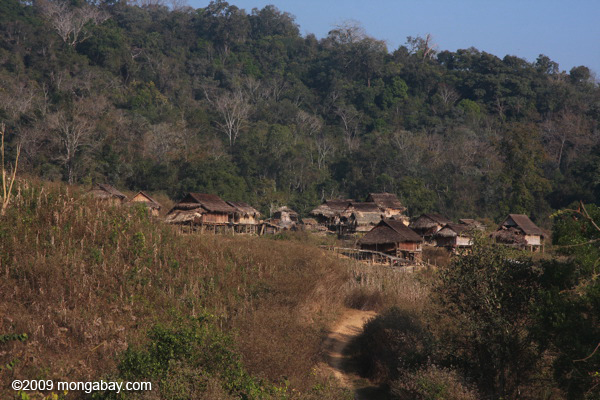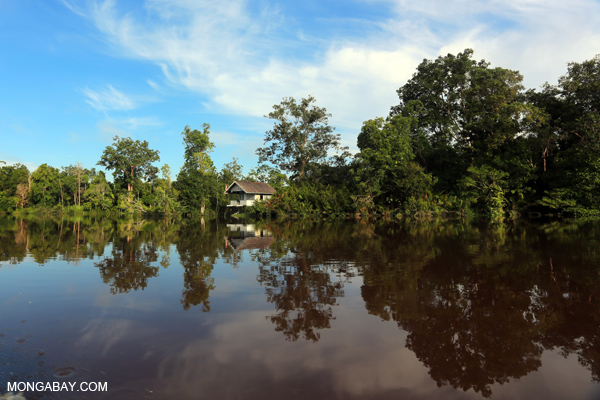- Many conservationists have long supported local communities and indigenous peoples seeking recognition of their rights to land and natural resources.
- In addition to being the right thing to do, supporting these local initiatives in land and seascapes across the globe helps strengthen the constituency for conserving healthy wildlife populations, habitats, and natural ecosystems.
- This post is a commentary. The views expressed are those of the authors, not necessarily Mongabay.
Michael Painter directs the Conservation and the Quality of Human Life Program at the Wildlife Conservation Society. The views expressed in this commentary are his own.

Village near Nam Et-Phou Louey National Protected Area in Lao PDR. Photo by Rhett A. Butler
Many conservationists have long supported local communities and indigenous peoples seeking recognition of their rights to land and natural resources. In addition to being the right thing to do, supporting these local initiatives in land and seascapes across the globe helps strengthen the constituency for conserving healthy wildlife populations, habitats, and natural ecosystems.
Unfortunately, conservation organizations have not been systematic in identifying and backing opportunities to support indigenous and community rights. Those missed opportunities have perpetuated perceptions that conservation is at odds with the aspirations of local communities and indigenous people for a better quality of life.
That’s a shame. The ability of many indigenous peoples and local communities to improve their quality of life is unquestionably tied to healthy biodiversity and ecosystems. At the 2010 Conference of the Parties to the Convention on Biodiversity in Japan’s Aichi Prefecture, goals were set to conserve at least 17 percent of the earth’s terrestrial and inland water areas and 10 percent of its coastal and marine areas by 2020.
The best way to achieve the so-called “Aichi Targets” is by establishing effective partnerships with local stewards. Supporting the rights of indigenous peoples and communities makes it more difficult for powerful interests simply to appropriate areas that are important for local people and wildlife, and clarifies critical issues of management authority and responsibility.

Local forest guard in Indonesia’s Ujung Kulon National Park.
Conservation organizations are well placed to support indigenous peoples and local communities in building the capacity to assume the technical and administrative challenges that inevitably follow on the recognition of rights. Such support is critical as they deal with the challenges posed by infrastructure construction, extractive industries, and the risks and opportunities associated with production contracts and joint venture agreements with tourism operators, timber companies, agro-industries, and other enterprises interested in their land, natural resources and labor.
In these settings, support for indigenous peoples and local communities also creates possibilities to construct institutional arrangements that permit funding streams supporting activities that are important for conservation that are not reliant on perpetual donor subsidies.
Conservation organizations can do several things to ensure that building partnerships with local communities and indigenous peoples is a consistent focus of our work. One is to make addressing governance issues that affect the political legitimacy of protected areas a central place in how we approach conservation.
Another is to ensure that we are able to identify and address situations in which conservation objectives are stalled because of a lack of recognition of land and resource rights of local communities and indigenous peoples is creating obstacles or disincentives to effective management. In such settings, supporting the formal recognition of customary land and natural resource rights can help remove bottlenecks that arise when there’s uncertainty about where management authority and responsibility reside.

Loita-Purko village at the base of the Loita Hills in Kenya.
We can strengthen ourselves in these areas by incorporating indicators that measure governance, livelihoods and external threats to local people and wildlife, in addition to those focusing on wildlife populations and their habitats.
Eight leading conservation organizations are working together through the Conservation Initiative on Human Rights to build this capacity into our own programs. We are also working to establish best practices that help make the broader conservation community more effective in addressing issues that arise where the struggles of indigenous peoples and local communities for recognition of their rights and critical conservation objectives intersect.
At the recently-completed World Parks Congress, in Sydney, Australia, delegates considered the future role of protected areas in safeguarding biodiversity, ecosystems, and the natural patrimony of the planet on which we all depend.
A recurring theme was that while protected areas are essential in achieving conservation targets, establishing the coverage called for in the Aichi Targets depends on how adjacent areas are managed, as well as effective support for land and resource management initiatives taking place outside of traditional protected areas that are consistent with biodiversity conservation goals.
Partnerships that recognize the land and resource rights of local communities and indigenous peoples build upon the contributions that community and indigenous areas are already making to conserving biodiversity and natural ecosystems. Such collaborations can also give conservation efforts political support that it might otherwise lack.
Collaborations with local groups can build the conservation constituencies required to address challenges presented by global trends such as the increasing concentration of people in urban areas and growing consumer demand for more, and better, food and other goods and services. Those efforts are essential to conserving the biodiversity and ecosystems underpinning all life.

Guard outpost in Central Kalimantan, Indonesia.
Michael Painter directs the Conservation and the Quality of Human Life Program at the Wildlife Conservation Society. He has directed WCS country programs in Bolivia and Peru, as well as WCS’s Amazon program, where he made building partnerships with local communities and indigenous peoples a central element of WCS’s conservation approach. He also represents WCS in the Conservation Initiative on Human Rights.